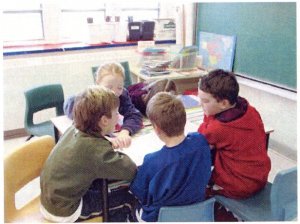

The goal of literature circles as defined by
Campbell Hill, et al. (1995) is "...not to dissect and
explain the book so that everyone comes to a
common understanding. Rather, meaning making
depends upon the experiences and contributions
each reader brings to a discussion. Reading should
stir up human feelings, prompting responses that
are sometimes deeply and personally felt" (p. 9).
Literature circles are also viewed as a viable means to provide authentic or meaningful reading experiences by engaging students in reading "real" books (Daniels, 1994, 2002; Campbell Hill, et. al., 1995; Routman, 1994). Daniels (2002, p. 38) further substantiates literature circles as authentic reading experiences by referring to the work of Keene and Zimmerman: 'We have found that the most authentic, and therefore, successful application of the strategies is in the context of book clubs-small groups of children talking regularly about books and the strategies they use to understand them.'
A review of the research on literature circles supports the goal of reader response to promote literacy activities that would lead to developing life-long readers. Responding to books through discussion, writing a personal reaction, representing artistically, or selecting passages to share, promotes a love for literature and positive attitudes toward reading which contribute to the development of life-long readers (Daniels, 1994, 2002; Campbell Hill, et. al., 1995). Accordingly, Routman (1994) reinforces this stance by stating, "The way students are asked to respond to literature in school influences their development as readers, writers, and thinkers as well as their enjoyment of literature" (p. 133).
Literature circles provide a framework for learning through social interaction and support. Daniels (1994) states "Literature circles embody the idea that kids learn to read mainly by reading and to write mainly by writing and by doing so in a supportive, literate community" (p. 24). The limited size of the discussion groups invites and requires all group members to be active participants by sharing ideas, constructing interpretations, sharing visualizations, correcting misunderstandings, making connections and predictions, sustaining energy, and keeping the process going (Daniels, 1994; Routman, 1994).